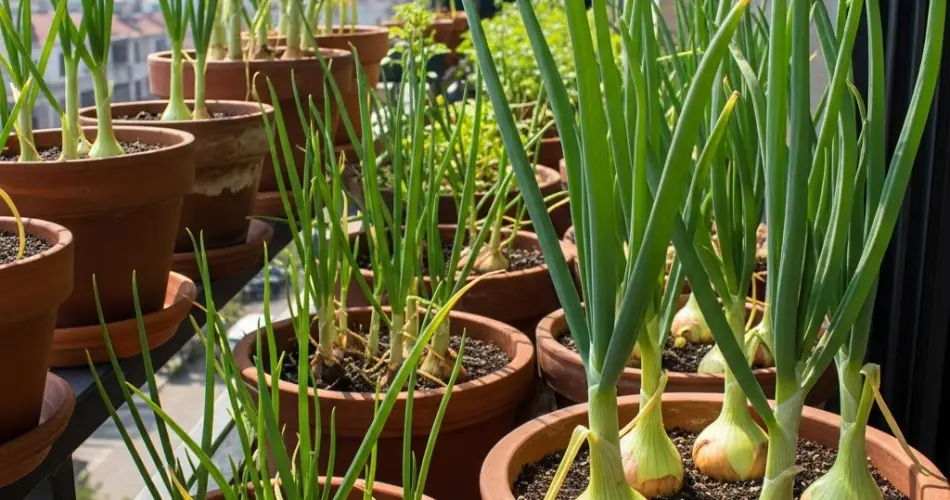Onions are an essential kitchen staple, and the good news is—they’re easy to grow even if you don’t have a backyard. A sunny balcony, a few pots, and the right care are all you need to enjoy a steady supply of homegrown onions. Whether you use them fresh, cooked, or dried, growing onions in containers is a satisfying way to ensure you always have some on hand. Here’s how to do it successfully.
Choosing the Right Onion Variety
Start by selecting the type of onion that suits your needs and climate. Onions come in several forms—bulb onions, green onions (scallions), and bunching onions.
-
Short-day onions are ideal for warmer climates with mild winters, as they begin forming bulbs when daylight is around 10–12 hours.
-
Long-day onions are better suited for cooler regions, as they need about 14–16 hours of daylight to bulb.
-
Day-neutral onions are a great middle ground and perform well in most areas regardless of daylight length.
For container growing, bunching onions or smaller bulb varieties are easiest. Varieties like ‘White Lisbon’, ‘Evergreen Bunching’, or ‘Red Baron’ work particularly well in pots.
Preparing the Container and Soil
Container size:
Use pots that are at least 8–10 inches (20–25 cm) deep. You can grow several onions in one large container or space them out in multiple small pots. Rectangular balcony planters or fabric grow bags also work well.
Drainage:
Make sure your containers have drainage holes to prevent waterlogging, which can lead to root rot.
Soil:
Onions prefer loose, well-draining soil that’s rich in organic matter. A good mix would be equal parts compost, potting soil, and sand or perlite. This helps the bulbs develop properly without compacted soil blocking their growth.
Planting Onions in Pots
You can grow onions from seeds, sets (small immature bulbs), or transplants.
-
Seeds take longer and should be started indoors 8–10 weeks before the last frost.
-
Sets are the easiest and fastest method, ideal for beginners.
-
Transplants are young seedlings sold at garden centers, usually available in spring.
Spacing:
Plant sets or transplants about 4 inches (10 cm) apart and 1 inch (2.5 cm) deep. For scallions or green onions, you can space them more closely—about 2 inches (5 cm) apart.
After planting, gently water the soil to help it settle around the roots or bulbs.
Sunlight and Watering
Light:
Onions need full sun to thrive—at least 6–8 hours of direct sunlight per day. Place your containers in the sunniest part of your balcony.
Water:
Keep the soil evenly moist but not soggy. Onions have shallow roots, so they need consistent moisture, especially during dry spells. Water when the top inch of soil feels dry, and avoid letting the soil dry out completely.
Mulching with straw or shredded leaves can help retain moisture and suppress weeds.
Feeding and Care
Onions are moderate feeders. Feed them every 2–3 weeks with a balanced liquid fertilizer or a low-nitrogen organic fertilizer. Too much nitrogen can lead to lots of leafy growth but smaller bulbs.
Remove any weeds that appear, as they can compete with onions for nutrients and water. Also, keep an eye out for pests like onion maggots and thrips. You can protect young plants with fine mesh covers or use natural sprays like neem oil if needed.
Harvesting
For green onions, you can begin harvesting when the leaves are about 6 inches (15 cm) tall. Use scissors or gently pull them out as needed.
For bulb onions, wait until the tops begin to yellow and flop over. This means the bulbs have matured. Stop watering at this point and allow the bulbs to cure in the sun for a few days to harden the outer skins. Once cured, trim the leaves and store the bulbs in a cool, dry place.
If you want a continuous supply of green onions, plant a few new sets every couple of weeks during the growing season.
Final Tips
-
Rotate your containers occasionally to ensure even sunlight exposure.
-
Refrain from overwatering, especially as the bulbs begin to mature.
-
Use labels if you’re growing different onion varieties to keep track of maturity dates.
-
Companion planting with herbs like chamomile or dill can help deter pests naturally.
Growing onions in pots is not only space-efficient but also low-maintenance and productive. With just a bit of care and attention, your balcony can become a thriving mini garden, supplying you with fresh, flavorful onions for your cooking all season long.



